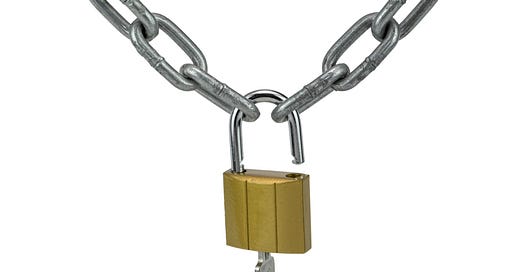When Protections Aren’t Protections
Consumer protections in sports betting suffer from weak rules, misfires, PR stunts, and blind spots, and are more about optics than stopping harm.
When is a consumer protection not a consumer protection?
When they have any of the following:
Structural weaknesses: Regulations that look good on paper but lack teeth.
Design flaws: Protections that overreach or misfire.
Political distortions: Optics over substance (like 21+ or a mandatory pop-up).
Behavioral blind spots: Ignore the psychology of gambling.
Or, more simply put, when it’s more about optics and managing fallout than preventing it.
SPONSOR’S MESSAGE - Yes, Sporttrade is indeed a prediction market. Always has been.
There’s a lot of hand-wringing about the excesses of the sports betting industry, and everyone and their cousin is suggesting fixes under the auspices of protecting the consumer. Most of these suggestions fall short.
Deposit Limits for the Top 1%
A proposal setting deposit limits from Illinois Senator Bill Cunningham is a perfect example of a policy that ticks off all four boxes. Cunningham’s bill would amend the state’s sports betting law to include:
“Provides that a sports wagering licensee: (1) shall not accept more than 5 deposits from an individual during a 24-hour period; (2) shall not accept deposits made by using a credit card; and (3) shall be required, before accepting deposits from a patron in an amount of more than $1,000 during a 24-hour period or $10,000 during a 30-day period, to conduct an affordability check.”
This isn’t a Cunningham problem; it’s a problem for most deposit limit proposals.
NCLGS Model Legislation capped deposits at an even higher level: $20,000 in 24 hours.
Even the extremely anti-gambling bill that has been introduced in Massachusetts sets limits way too high, at $1,000/day, $10,000/month max without an affordability check.
So the question is: Who is this protecting? Fortune 500 CEOs?
Deposit caps of any level run the risk of pushing VIPs offshore, but when the cap is set so high that it doesn’t protect 99% of bettors, what is it accomplishing?
As I said in my NCLGS model legislation writeup:
“The daily deposit threshold is so high that it cannot possibly have an RG impact. It would have been better to say nothing about a daily deposit limit than to recommend such a ridiculously high threshold ($20,000 in a 24-hour period).
“First off, it’s useless. Every licensed operator would (or should!) run a source of funds check on a customer trying to deposit $20,000 in a single day. Under the NCLGS model legislation, a person could still deposit six figures weekly.
“I would argue that this policy could have a negative, unintended consequence. Operators could conceivably use the $20,000 limit to raise their source of funds threshold checks.”
Here’s why I’m not sold on deposit limits (as currently proposed):
Structural Weakness: The thresholds are set so high it’s like trying to catch mosquitos with a fishing net. Operators should already flag a bettor making $10,000 or $20,000 monthly (nevermind daily) deposits for source-of-funds checks, rendering the rule ineffective.
Design Flaw: By focusing on a dollar amount rather than a percentage of income, the policy misses 99% of customers. Worse, it could backfire. As I noted in my NCLGS model legislation writeup: “Operators could conceivably use the $20,000 limit to raise their source-of-funds threshold checks,” creating unintended loopholes instead of tighter control.
Political Distortion: These caps reek of symbolism—five deposits a day sounds like you're trying to curb problematic behavior and affordability checks sound proactive—but they’re arbitrary numbers and meaningless when set so high. It’s a 21+ label in legislative form: flashy enough to signal responsibility, hollow enough to avoid disrupting revenue.
Behavioral Blind Spot: Deposit limits ignore gambling psychology entirely, especially when the caps are too high. Customers will find easy ways around them — signing up at a dozen sportsbooks — and illegal ones, like multi-accounting and identity theft. It’s a superficial fix that assumes any cap is better than none, even when it has enough workarounds to make it useless and could be used by bettors to justify their spend up to the cap.
National Self-Exclusion Efforts are Another Miss
Another well-meaning but highly flawed policy is the recent national self-exclusion push.
The problem, and not the only problem, is that this is likely to discourage people from self-excluding, as they’re not only excluding from an online operator but possibly from land-based casinos, as some operators have a blanket self-exclusion policy. If national self-exclusion exists, and someone in Kansas excludes themselves from any sports betting app, they may be denied entrance at casinos on their next trip to Las Vegas. That will surely make them think twice about self-excluding from their home state’s mobile betting apps.
I’m also curious how the industry squares the circle that some policies push bettors offshore, but something like this doesn’t. Note that the charges against High5Games in Connecticut allege the company allows self-excluded gamblers to wager money on their games.
Bettors deciding to self-exclude should have many options, not a blanket ban. That will encourage them to exclude and keep them from heading offshore or trying to skirt their ban by setting up a fake account or sneaking into a casino.
Here’s why I’m not sold on blanket national self-exclusion:
Keep reading with a 7-day free trial
Subscribe to Straight to the Point to keep reading this post and get 7 days of free access to the full post archives.




